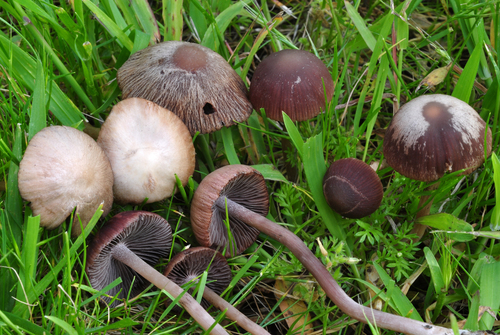Psathyrella sp.
PsathyrellaSummary 7
Psathyrella is a large genus of about 400 species, and is similar to the genera Coprinellus, Coprinopsis, Coprinus and Panaeolus, usually with a thin cap and white or yellowish white hollow stem. The caps do not self digest as do those of Coprinellus and Coprinopsis. Some also have brown spores rather than black. These fungi are often drab-colored, difficult to identify, and inedible, and so they are sometimes considered uninteresting. Howev
Psathyrella: brief summary 8
Psathyrella is a large genus of about 400 species, and is similar to the genera Coprinellus, Coprinopsis, Coprinus and Panaeolus, usually with a thin cap and white or yellowish white hollow stem. The caps do not self digest as do those of Coprinellus and Coprinopsis. Some also have brown spores rather than black. These fungi are often drab-colored, difficult to identify, and all members are considered inedible or worthless (for eating) and so they are often overlooked. However they are quite common and can occur at times when there are few other mushrooms to be seen. The first report of a gilled mushroom fruiting underwater is Psathyrella aquatica.
The genus name Psathyrella is a diminutive form of Psathyra, derived from the Greek word ψαθυρος, psathuros 'friable'. The type species of Psathyrella is Psathyrella gracilis, which is now known as Psathyrella corrugis.
Sources and Credits
- (c) noah_siegel, some rights reserved (CC BY-NC-SA), uploaded by noah_siegel
- (c) anonymous, some rights reserved (CC BY-NC), https://eol.org/media/10825573
- (c) anonymous, some rights reserved (CC BY-SA), https://eol.org/media/10880550
- (c) anonymous, some rights reserved (CC BY-SA), https://eol.org/media/10881284
- (c) anonymous, some rights reserved (CC BY-NC-SA), https://eol.org/media/10882440
- (c) anonymous, some rights reserved (CC BY-NC-SA), https://eol.org/media/10885767
- (c) Wikipedia, some rights reserved (CC BY-SA), https://en.wikipedia.org/wiki/Psathyrella
- (c) Wikipedia authors and editors, some rights reserved (CC BY-SA), http://eol.org/data_objects/27880678










